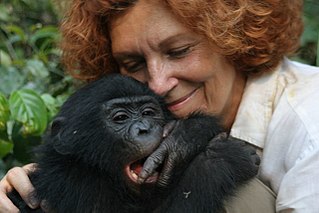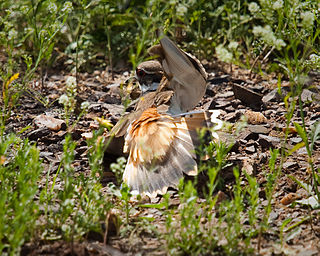Related Research Articles

Hummingbirds are birds native to the Americas and comprise the biological family Trochilidae. With about 366 species and 113 genera, they occur from Alaska to Tierra del Fuego, but most species are found in Central and South America. About 28 hummingbird species are listed as endangered or critically endangered, with numerous species declining in population.

In zoology, a crepuscular animal is one that is active primarily during the twilight period, being matutinal, vespertine/vespertinal, or both. This is distinguished from diurnal and nocturnal behavior, where an animal is active during the hours of daylight and of darkness, respectively. Some crepuscular animals may also be active by moonlight or during an overcast day. Matutinal animals are active only before sunrise, and vespertine only after sunset.

Animal cognition encompasses the mental capacities of non-human animals including insect cognition. The study of animal conditioning and learning used in this field was developed from comparative psychology. It has also been strongly influenced by research in ethology, behavioral ecology, and evolutionary psychology; the alternative name cognitive ethology is sometimes used. Many behaviors associated with the term animal intelligence are also subsumed within animal cognition.

The giant hummingbird is the only member of the genus Patagona and the largest member of the hummingbird family, weighing 18–24 g (0.63–0.85 oz) and having a wingspan of approximately 21.5 cm (8.5 in) and length of 23 cm (9.1 in). This is approximately the same length as a European starling or a northern cardinal, though the giant hummingbird is considerably lighter because it has a slender build and long bill, making the body a smaller proportion of the total length. This weight is almost twice that of the next heaviest hummingbird species and ten times that of the smallest, the bee hummingbird.
The term laterality refers to the preference most humans show for one side of their body over the other. Examples include left-handedness/right-handedness and left/right-footedness; it may also refer to the primary use of the left or right hemisphere in the brain. It may also apply to animals or plants. The majority of tests have been conducted on humans, specifically to determine the effects on language.

The sulphur-crested cockatoo is a relatively large white cockatoo found in wooded habitats in Australia, New Guinea, and some of the islands of Indonesia. They can be locally very numerous, leading to them sometimes being considered pests. A highly intelligent bird, they are well known in aviculture, although they can be demanding pets.

The blue-black grassquit is a small Neotropical bird in the tanager family, Thraupidae. It is the only member of the genus Volatinia. It is a common and widespread bird that breeds from southern Mexico through Central America, and South America as far as northern Chile, Argentina, and Paraguay, and in Trinidad and Tobago. A male was also observed in Graham County, Arizona on July 15 and July 17, 2023.

Kinji Imanishi was a Japanese ecologist and anthropologist. He was the founder of Kyoto University's Primate Research Institute and, together with Junichiro Itani, is considered one of the founders of Japanese primatology.

Human–animal communication is the communication observed between humans and other animals, ranging from non-verbal cues and vocalizations to the use of language.

The woodpecker finch is a monomorphic species of bird in the Darwin's finch group of the tanager family, Thraupidae endemic to the Galapagos Islands. The diet of a woodpecker finch revolves mostly around invertebrates, but also encompasses a variety of seeds. Woodpecker finches, like many other species of birds, form breeding pairs and care for young until they have fledged. The most distinctive characteristic of woodpecker finches is their ability to use tools for foraging. This behaviour indicates that they have highly specialized cognitive abilities. Woodpecker finches have also shown the ability to learn new behaviours regarding tool use via social learning. Not all populations of woodpecker finches use tools equally often, as this is influenced by the environment in which they live.

The difficulty of defining or measuring intelligence in non-human animals makes the subject difficult to study scientifically in birds. In general, birds have relatively large brains compared to their head size. The visual and auditory senses are well developed in most species, though the tactile and olfactory senses are well realized only in a few groups. Birds communicate using visual signals as well as through the use of calls and song. The testing of intelligence in birds is therefore usually based on studying responses to sensory stimuli.
Animal culture can be defined as the ability of non-human animals to learn and transmit behaviors through processes of social or cultural learning. Culture is increasingly seen as a process, involving the social transmittance of behavior among peers and between generations. It can involve the transmission of novel behaviors or regional variations that are independent of genetic or ecological factors.

Cat intelligence is the capacity of the domesticated cat to solve problems and adapt to its environment. Research has shown that feline intelligence includes the ability to acquire new behavior that applies knowledge to new situations, communicating needs and desires within a social group and responding to training cues.

Mate choice is one of the primary mechanisms under which evolution can occur. It is characterized by a "selective response by animals to particular stimuli" which can be observed as behavior. In other words, before an animal engages with a potential mate, they first evaluate various aspects of that mate which are indicative of quality—such as the resources or phenotypes they have—and evaluate whether or not those particular trait(s) are somehow beneficial to them. The evaluation will then incur a response of some sort.

Tool use by non-humans is a phenomenon in which a non-human animal uses any kind of tool in order to achieve a goal such as acquiring food and water, grooming, combat, defence, communication, recreation or construction. Originally thought to be a skill possessed only by humans, some tool use requires a sophisticated level of cognition. There is considerable discussion about the definition of what constitutes a tool and therefore which behaviours can be considered true examples of tool use. A wide range of animals, including mammals, birds, fish, cephalopods, and insects, are considered to use tools.

Distraction displays, also known as diversionary displays, or paratrepsis are anti-predator behaviors used to attract the attention of an enemy away from something, typically the nest or young, that is being protected by a parent. Distraction displays are sometimes classified more generically under "nest protection behaviors" along with aggressive displays such as mobbing. These displays have been studied most extensively in bird species, but also have been documented in populations of stickleback fish and in some mammal species.

In animal behaviour, stereotypy, stereotypic or stereotyped behaviour has several meanings, leading to ambiguity in the scientific literature. A stereotypy is a term for a group of phenotypic behaviours that are repetitive, morphologically identical and which possess no obvious goal or function. These behaviours have been defined as 'abnormal', as they exhibit themselves solely in animals subjected to barren environments, scheduled or restricted feedings, social deprivation and other cases of frustration, but do not arise in 'normal' animals in their natural environments. These behaviours may be maladaptive, involving self-injury or reduced reproductive success, and in laboratory animals can confound behavioural research. Stereotypical behaviours are thought to be caused ultimately by artificial environments that do not allow animals to satisfy their normal behavioural needs. Rather than refer to the behaviour as abnormal, it has been suggested that it be described as "behaviour indicative of an abnormal environment".
Time-place learning (TPL) is the process by which animals link events with both the location and time of occurrence. It enables them to decide which locations to visit or to avoid based on previous experience and knowledge of the current time of day. TPL presumably allows animals to maximize their chances of finding resources and avoiding predators, increasing survival chances. TPL requires spatial memory and a sense of time. The latter may be based on external time-cues (Zeitgebers), or internally generated circadian rhythms. TPL may fundamentally underlie episodic memory.

Insect cognition describes the mental capacities and study of those capacities in insects. The field developed from comparative psychology where early studies focused more on animal behavior. Researchers have examined insect cognition in bees, fruit flies, and wasps.
William D. Timberlake was a psychologist and animal behavior scientist. His work included behavioral economics, contrast effects, spatial cognition, adjunctive behavior, time horizons, and circadian entrainment of feeding and drug use. He is best known for his theoretical work: Behavior Systems Theory and the Disequilibrium Theory of reinforcement.
References
- 1 2 "Professor Susan Healy FRSE". The Royal Society of Edinburgh. 5 May 2021. Retrieved 12 October 2021.
- ↑ Krebs, J. R.; Sherry, D. F.; Healy, S. D.; Perry, V. H.; Vaccarino, A. L. (1 February 1989). "Hippocampal specialization of food-storing birds". Proceedings of the National Academy of Sciences. 86 (4): 1388–1392. Bibcode:1989PNAS...86.1388K. doi: 10.1073/pnas.86.4.1388 . ISSN 0027-8424. PMC 286696 . PMID 2919184.
- ↑ Healy, Sue; Walsh, Patrick; Hansell, Mike (8 April 2008). "Nest building by birds". Current Biology. 18 (7): R271–R273. doi: 10.1016/j.cub.2008.01.020 . ISSN 0960-9822. PMID 18397728. S2CID 824546.
- ↑ Harris, Anjanette P.; D'eath, Richard B.; Healy, Susan D. (November 2008). "Sex differences, or not, in spatial cognition in albino rats: acute stress is the key". Animal Behaviour. 76 (5): 1579–1589. doi:10.1016/j.anbehav.2008.07.016. S2CID 53205348.
- ↑ Samuels, Michael; Hurly, T. Andrew; Healy, Susan D. (1 November 2014). "Colour cues facilitate learning flower refill schedules in wild hummingbirds". Behavioural Processes. Animal Cognition in the Wild. 109: 157–163. doi:10.1016/j.beproc.2014.09.007. ISSN 0376-6357. PMID 25234604. S2CID 16258240.
- ↑ Rowe, Candy; Healy, Susan D. (2014). "Measuring cognition will be difficult but worth it: a response to comments on Rowe and Healy". Behavioral Ecology. 25 (6): 1298. doi:10.1093/beheco/aru190. hdl: 10.1093/beheco/aru190 . ISSN 1465-7279.
- ↑ Breen, Alexis J.; Healy, Susan D.; Guillette, Lauren M. (1 December 2021). "Reproductive consequences of material use in avian nest construction". Behavioural Processes. 193: 104507. doi:10.1016/j.beproc.2021.104507. hdl: 10023/26054 . ISSN 0376-6357. PMID 34562513. S2CID 237603148.
- ↑ Tello-Ramos, Maria C.; Hurly, T. Andrew; Barclay, Mabel; Healy, Susan D. (2 August 2021). "Hummingbirds modify their routes to avoid a poor location". Learning & Behavior. 50 (1): 89–98. doi:10.3758/s13420-021-00476-3. ISSN 1543-4494. PMC 8979907 . PMID 34341946. S2CID 236884788.
- ↑ Lewis, Mark A.; Fagan, William F.; Auger-Méthé, Marie; Frair, Jacqueline; Fryxell, John M.; Gros, Claudius; Gurarie, Eliezer; Healy, Susan D.; Merkle, Jerod A. (9 July 2021). "Learning and Animal Movement". Frontiers in Ecology and Evolution. 9: 681704. doi: 10.3389/fevo.2021.681704 . hdl: 10023/23569 . ISSN 2296-701X.
- ↑ Sugasawa, Shoko; Webb, Barbara; Healy, Susan D. (31 March 2021). "Object manipulation without hands". Proceedings of the Royal Society B: Biological Sciences. 288 (1947): rspb.2020.3184, 20203184. doi:10.1098/rspb.2020.3184. ISSN 0962-8452. PMC 8059664 . PMID 33726598.
- 1 2 3 4 "Susan Healy - Research publications - University of St Andrews". risweb.st-andrews.ac.uk. Retrieved 12 October 2021.
- ↑ "Editorial Board - Animal Behaviour - Journal - Elsevier". www.journals.elsevier.com. Retrieved 12 October 2021.
- ↑ "Animal Cognition". Springer. Retrieved 12 October 2021.